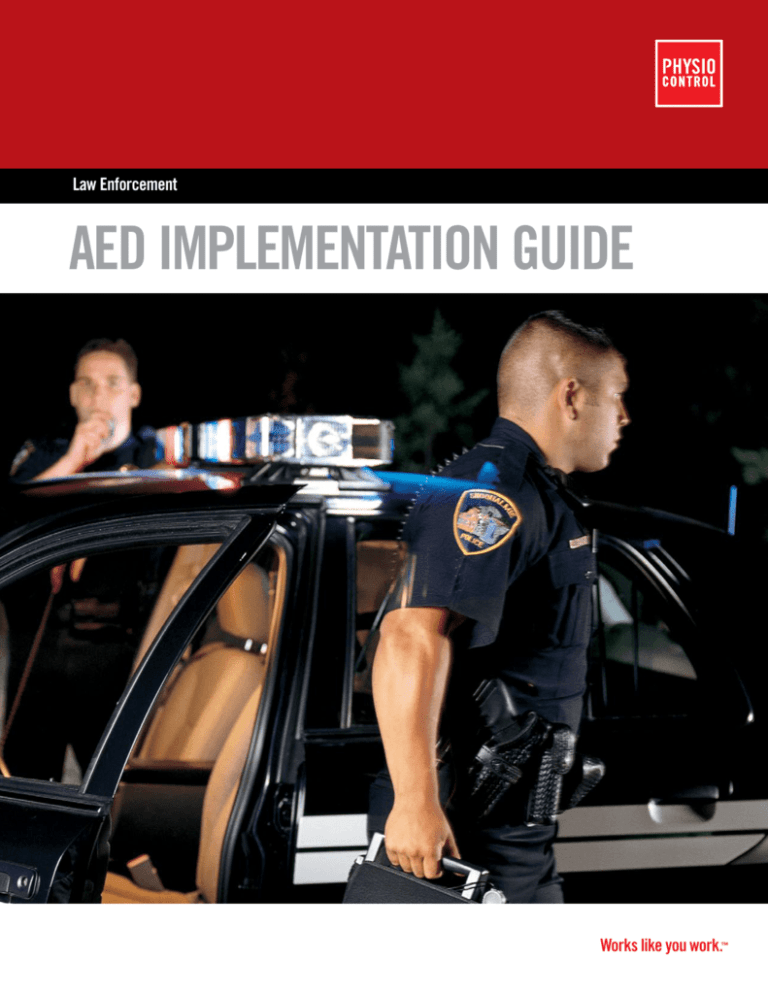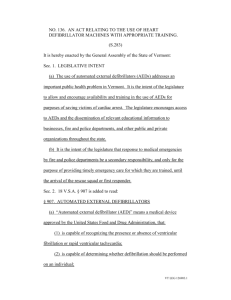AED Implementation Guide For Law Enforcement
advertisement

Law Enforcement AED IMPLEMENTATION GUIDE Works like you work.™ “After the third shock, her heart started right up. By then, the paramedics arrived; I knew she was doing all right when she started arguing with them.” Officer John Hannah, Rye Police, New York YOUR GUIDE TO PUTTING A HEART SAFE AED PROGRAM IN PLACE Police and other law enforcement officers have a vital role to play in fighting a major killer—sudden cardiac arrest (SCA). The public safety arsenal is expanding to include automated external defibrillators (AEDs) to give anyone struck down by SCA another chance at life.* Sudden cardiac arrest can happen anywhere, anytime—to people of all ages in all walks of life, including law enforcement officers. An electrical malfunction that makes the heart quiver in a deadly rhythm called ventricular fibrillation (VF) usually causes SCA. A lifesaving pulse of electricity is the single most effective way to restore the heart’s normal rhythm. Physio-Control LIFEPAK 1000 Defibrillator Every minute counts. Only about 5 percent of people struck down by SCA survive. But if people in VF get CPR and the lifesaving AED shock within 3 minutes of collapse, the survival rate can increase up to 74 percent.1 Reducing response time by even 1 or 2 minutes from collapse to shock can mean the difference between death and survival. 2 In Miami-Dade County, equipping police officers with AEDs nearly doubled the survival rate from SCA for people in VF. 3 As you can see, it could be a matter of life and death to have AEDs within easy reach of law enforcement officers who are trained to use them. Who’s often first on the scene in an emergency? • Police officers, sheriff ’s deputies and highway patrol, whose units are on the road while fire trucks and ambulances may be parked at the station or transporting patients • Correctional officers responding to incidents involving prisoners and fellow officers long before EMS makes its way within a secured facility • Specialty police, such as search and rescue, treasury agents and SWAT teams, operating in remote, undercover and dangerous situations Communities recognize the benefit of equipping patrol units, police precincts, jails and prisons with lifesaving AEDs. Because early defibrillation is becoming the standard of care in many communities, the public will increasingly expect officers to arrive on the scene not only with their radios and firearms, but with AEDs as well. No two law enforcement agencies or facilities will implement an AED program in exactly the same way. This guide outlines steps to help you tailor a program that works for your situation. * Although not everyone can be saved from sudden cardiac arrest, studies show that early defibrillation can dramatically improve survival rates. Law Enforcement AED Implementation Guide To help ensure success, put someone in charge of coordinating your efforts. Be sure to cover these bases: GET READY • Assign a project coordinator • Champion the idea and gain consensus • Review laws and regulations or consult your agency’s legal counsel or risk manager • Coordinate with local emergency medical services (EMS) GET SET • Arrange for medical direction • Plan how to dispatch AED-equipped officers • Choose your equipment and vendor • Design policies and procedures • Assess how many AEDs you’ll need and where they’ll do the most good • Develop and fund a budget for equipment, training and Public Relations • Train officers and plan for refresher training GO • Acquire and deploy AEDs and other supplies • Promote your program to raise awareness and support • Build quality assurance into your operation At Physio-Control, we’re here to help every step of the way. A team of AED specialists is available for consultation as needed. Call your sales consultant at 1-800-442-1142 or visit www.aedhelp.com. “To use the defibrillator successfully was a damn good feeling, but it’s an even better feeling to stop by Adele’s house and see she’s doing just fine.” Officer John Hannah, Rye Police, New York CHAMPION THE IDEA AND GAIN CONSENSUS A law enforcement officer trained and armed with an AED plays a vital role in the tiered response system. To implement a successful early defibrillation program, you’ll need support from the top of your organization and from the rank and file. It helps to have a strong champion for your program. Of course you’ll want backing from top management such as the police chief, sheriff or superintendent and from union leadership, if possible. But don’t overlook other key players, such as your community’s EMS team, communications center leadership, and your agency’s legal counsel and risk manager. Early in the process, form a cross-functional team representing the many areas that will be touched by the program, from Law Enforcement AED Implementation Guide planning to operations. Arrange a meeting so people can air their concerns and you can build support among decision makers. Winning political approval can also make the program more successful. The mayor, city council and county commissioners not only hold the purse strings, but may champion the program, especially if they have a personal reason to do so, such as losing a family member to SCA or heart attack in a situation where medical response was delayed. If your program needs approval at the polls, you’ll want to target voters. Presentation materials are available to help spread the word about how AEDs can help guardians of public safety make a difference between life and death. “...use of automatic external defibrillators by police officers could result in the saving of countless lives...”4 International Association of Chiefs of Police REVIEW LAWS AND REGULATIONS AEDs are designed to analyze the heart’s rhythm and advise whether a shock is needed, so they can be safely and easily used by anyone with minimal training. Delivering a defibrillation shock requires very little decision-making on the part of the rescuer. Still, law enforcement agencies are concerned about their liability for acquiring and using AEDs. In the United States, the Cardiac Arrest Survival Act of 2000 encourages placement of AEDs in federal buildings—including prisons—and offers federal liability protection for users, purchasers and trainers of AEDs. Good Samaritan laws in all 50 states grant civil immunity to people who use an AED in an emergency, but not all laws cover people acting in the line of duty. Because court decisions, laws and regulations regarding AED use vary depending on your locale, your legal and risk management staff will be your best resources for advising you in setting up and running your program. They may put to rest any concerns and point out that as AED use is becoming the standard of care, communities may risk liability for failing to provide defibrillation as part of emergency response. Typically, AED laws and regulations require: • Training to operate an AED • Coordination with the emergency medical service in your community • Medical direction • Record-keeping for each use of an AED • Regular maintenance of the equipment For more information regarding laws pertaining to AED use, visit www.aedhelp.com Law Enforcement AED Implementation Guide COORDINATE WITH LOCAL EMERGENCY MEDICAL SERVICES (EMS) Early defibrillation by a first responder such as a police or corrections officer is just one link in the “Chain of Survival” defined by the American Heart Association, which requires: . Early recognition and reporting of emergencies like cardiac arrest Survival rates will suffer without coordinated response to cardiac emergency calls and timely hand-off to EMS. 2. CPR initiated quickly by bystanders 3. Early defibrillation by the first responders, such as law enforcement, fire, or ambulance crew 4. Advanced cardiac life support by medical professionals to stabilize the victim As you can see, a law enforcement officer trained and equipped with an AED plays a vital role in the multi-level response system, which includes CPR by bystanders, defibrillation and basic life support by first responders, and advanced life support by medical professionals. In many locations, notifying the local emergency medical services (EMS) system that you have AEDs is a requirement when you implement an AED program. In addition to being a partner in dispatch for cardiac emergencies, EMS can provide guidance on equipment choice and placement, training and medical direction. To ensure seamless delivery of care, it’s essential to have clear protocols for smooth handoff to EMS from the responding law enforcement officer. To download a sample form for notifying EMS if your AEDs are located in a building or other fixed location, go to www.aedhelp.com. ARRANGE FOR MEDICAL DIRECTION Although AEDs are designed for use by anyone with minimal training, the U.S. Food and Drug Administration classifies them as medical devices and most AEDs require a prescription from a physician. This physician often also serves as the “medical director” of an AED program. He or she is not expected to be on the scene of AED use, but provides ongoing medical oversight. The medical director provides the “standing orders” rescuers should follow when using an AED in a medical emergency. The physician may sign off on training plans and policies and procedures, update them to take into account new treatment recommendations, evaluate data recorded on an AED during a medical emergency, and help assess each use of an AED to suggest any improvements. Many states require medical authorization and documentation in order for legislation to cover an AED program. Law Enforcement AED Implementation Guide If you have a good working relationship with your local EMS, they can be very helpful in this area. In fact, the EMS medical director may be willing to act as yours also. This is ideal. If you are not well coordinated with EMS or prefer to branch out on your own, medical direction may be provided by: • An interested physician in the community or local hospital • A physician employed by your agency • The basic medical oversight programs available from Physio-Control PLAN HOW TO DISPATCH AED-EQUIPPED OFFICERS How you dispatch officers with AEDs will require close coordination with your local EMS system. Survival rates will suffer without coordinated response to cardiac emergency calls and timely hand-off to medical professionals who can provide advanced life support. Consolidated communications dispatch with simultaneous deployment of the closest law enforcement and EMS units is the ideal, but not necessary. How your jurisdiction handles it depends on your existing communications center. It’s essential that all response agencies coordinate their protocols, and continue to fine-tune procedures once officers with AEDs are being deployed. Good screening protocols will help communications centers ensure efficient and rapid deployment of AED-equipped officers. Several screening methods, known as Emergency Medical Dispatch (EMD), have been effective in medical call screening. EMD may assist your agency in managing the types of calls that AED-equipped officers respond to, and increase coordination with your existing EMS system. EMD requires additional training for dispatchers. At a minimum, your dispatch protocols should be specific and clearly identify medical problems that will trigger an AED response from your agency. If your agency uses mapping technology, you can add the locations of AEDs in the community to the system and assist in call screening and response. Should someone without knowledge of the AED program call for help, the dispatcher can let the caller know the location of the nearest AED. Other technologies, such as Automated Vehicle Location (AVL) devices, can also enhance the efficient use of AED-equipped police vehicles by allowing the closest unit to respond. Seek the advice of your local EMS and program medical director regarding the type of AEDs to buy. CHOOSE YOUR EQUIPMENT AND VENDOR Because of their experience and knowledge, your local EMS and program medical director can be very valuable in advising you regarding the type of AEDs to buy. Additionally, make sure you ask about the reputation of the vendor for reliability, durability and ongoing support. Selecting a single brand of AED will greatly simplify training and maintenance. Important considerations include: • Reputation of the AED manufacturer for product quality and customer service • Compatibility with the equipment of local EMS Law Enforcement AED Implementation Guide • Easy operation, with clear voice prompts • Semi- or fully-automatic mode • Biphasic technology with energy escalating to 360 Joules which enables the AED to adjust shocks and energy levels to the victim's needs • Defibrillation electrodes that are pre-connected to save precious seconds • Maintenance-free batteries • Direct field service for on-site download of AED data • Validated computer-based refresher training • Availability of reduced energy defibrillation electrodes for children younger than age eight • Data collection and management software • Vendor can provide a complete implementation solution LIFEPAK AEDs from Physio-Control are ideal for infrequent users, since voice and visual prompts guide users through operation. Automatic self-testing and an always-visible readiness display help assure the device is ready to go. Physio-Control offers several services needed to implement an AED program including: medical prescription, medical direction and oversight, training, post-event data download and data review. For more information visit: LIFEPAK CR® Plus and LIFEPAK® 1000 defibrillators http://physiocontrol.com/products/heartsafe.cfm. DESIGN POLICIES AND PROCEDURES—AND KEEP IMPROVING THEM As with all policies and procedures, be sure to update them as laws and regulations change, as best medical practices evolve, and as you learn from your own experience using AEDs. The groundwork you laid earlier will pay off as you develop policies and procedures that mesh smoothly with existing public safety duties and your local EMS system. If a state or national accreditation or certification program accredited your agency, be sure to check whether equipping your officers with AEDs affects any standards. As with other policies and procedures, those relating to AEDs will require periodic updating as laws and regulations change, as best medical practices evolve, and as you learn from your own experience using AEDs. Be sure to include: • Who manages the AED program • Who provides medical direction • Standing orders stating when the AED should be used, when it shouldn’t be used, and training required to use it • Types of calls that trigger AED dispatch, and how it will be coordinated with the community’s emergency medical services team • Types and locations of AEDs and related equipment (such as gloves and face mask for CPR) • Training and refresher training policy • A process and schedule for checking and maintaining equipment Law Enforcement AED Implementation Guide • Any records that must be kept each time an AED is used to satisfy departmental and any state reporting requirements • How to handle data the AED recorded during use (patient’s heart rhythm, AED assessment and any shock delivered) • What to do after an event, such as downloading and transferring data from the AED, notifying the medical director, reviewing the event to determine how procedures might be improved, stress debriefing, replenishing supplies, and returning the AED to service • A process to periodically review and update the policies and procedures. Be sure to have your medical director as well as your legal and risk management staff review your policies and procedures. Your AED program records should also include: operating instructions, contact information for your vendor, supply ordering information, training roster, and pertinent state laws and local regulations. ASSESS HOW MANY AEDs YOU’LL NEED AND WHERE THEY’LL DO THE MOST GOOD To achieve a good response time, you’ll want enough AEDs in the right places, a clear communications pipeline, and enough officers trained to respond quickly. You will want to provide defibrillation in less than 4 to 5 minutes—ideally in less than 3 minutes to achieve higher success rates. 5 Every additional minute of delay lowers the rate of successful resuscitation by 7 to 10 percent. 6 Ideally, you will equip every patrol unit with an AED and train every officer to use it. In corrections facilities, precincts and other buildings, your internal communication systems will greatly impact the time to respond. In the event of a sudden cardiac arrest, how will staff alert both external EMS and internal AED responders without delay? You can save precious seconds with automatic notification systems, such as wiring a monitored wall cabinet containing an AED so that opening the door triggers an alert to the communications center. You’ll particularly want coverage of places: • That are harder for EMS teams to reach (such as deep inside a facility, high in a tall building, and remote or locked locations) • Where people may be subject to strenuous activity, including exercise • With many older people, who are at higher risk for SCA There is no one simple formula that applies to all sites. Walking the facility, carrying a stopwatch and floor plans, is often the best way to determine the number of AEDs needed and specific locations. Ideally, you want a ‘drop to shock’ time no longer than 3 to 5 minutes. Walking at a brisk pace, you can cover about 300 feet per minute. You might take a phased approach, first placing AEDs in vehicles that patrol the most densely populated areas and in high-occupancy buildings or hard-to-reach locations, and equipping other spaces in later phases. Law Enforcement AED Implementation Guide DEVELOP AND FUND A BUDGET FOR EQUIPMENT, TRAINING AND PR Although adequate budget and staffing are constant concerns for public safety agencies, you can build a strong case for early defibrillation. With proper information, you can convince elected officials and budget committee members of the wisdom of spending money on lifesaving early defibrillation. Using population demographics, call volumes for cardiac arrests, and cost of equipment, you can calculate a projected “cost per life saved” figure. 7 Keep in mind that as AEDs become the standard of care, a jurisdiction may face liability for not having an early defibrillation program in place. Possible sources of funding include: • Government grants for emergency preparedness at the city, county, state and federal levels • Local corporations, insurance carriers and industries that would benefit • Business improvement districts or other taxing districts • Health plans, local hospitals and hospital guilds • Civic organizations, such as Rotary, Elks, Eagles and Lions clubs • Neighborhood Block Watch and other organizations that support police efforts • Private foundations After selecting a vendor, estimate your program costs. In addition to the AEDs, budget for: • Cost of initial training, refresher courses and related supplies such as AED training devices, extra training electrodes and manikins • Extra defibrillation electrodes and supplies such as pocket mask, scissors, gloves, razor (to shave chest hair if necessary), and towel (to dry chest area), which can be stored with the AED • Vehicle mounts, storage units or carrying cases for AEDs • Replacement of batteries and electrodes (which have expiration dates even if never used) • Device maintenance or service agreement, which is usually arranged with the AED vendor • Data management system, which may include a computer, modem, printer and software • AED replacement cost, such as a five-year amortized fund to pay for future units You may need to initiate your program in phases in order to distribute costs over time, especially in larger systems. Consider leasing or volume purchasing programs to keep costs down. Law Enforcement AED Implementation Guide TRAIN OFFICERS AND PLAN FOR REFRESHER TRAINING Strengthening the Chain of Survival requires more than training officers to use an AED. They should know how to quickly recognize signs of sudden cardiac arrest, notify others as needed, start CPR right away, locate and use the defibrillator, and care for a victim until the EMS team arrives. Training for officers in patrol units should include dispatch protocols. In facilities such as precincts, jails, prisons, and courthouses equipped with AEDs, training should also include how to notify both external EMS teams and internal AED responders without delay. It’s important to address concerns officers may have. Training will demonstrate that AEDs are easy to use, and in fact difficult to misuse, especially if devices have visual prompts and voice commands to guide rescuers. Officers who are concerned about liability may be reassured to learn the devices are intended for use on people who are clinically dead and are designed to analyze a patient’s heart rhythm and deliver a shock only if needed. Unless officers received training in AED use at the police academy, they should take standard training classes that meet the guidelines of a nationally recognized program, such as the American Heart Association, the American Red Cross and the National Safety Council. The classes give officers both the skills and confidence to intervene in a cardiac emergency. To make learning more effective, use scenarios that law enforcement officers are likely to face on the job. Be sure your training complies with state and local regulations. Often, immunity from civil liability applies only to people who have been trained to use an AED. Options include having courses taught on-site by an independent training company, or at a convenient location in the community through local EMS, a local hospital or community college. Some agencies adopt a “train the trainer” approach, where credentialed staff members instruct the training course. Training may also be available in the form of web-based training or CD-ROM. Your sales representative can also help locate appropriate training. Training will demonstrate that AEDs are easy to use, and in fact difficult to misuse, especially in devices with visual prompts and voice commands to guide users. Often, immunity from civil liability applies only to people who have been trained to use an AED. Once officers have completed the AED course, it is important to perform inservice training with an AED training device that looks like and acts like the “live” AED. This lets you simulate a wide range of possible scenarios and eliminates the need to take a “live” AED out of service. Keep good records of the officers trained, and when they need refresher courses. Plan for renewal training as you would for other periodic inservice training. Retraining should occur at least every two years—sooner if your policy, procedures or equipment changes. Computer-based refresher training (CBT) is a useful tool to keep skills sharp. This type of training can be readily available 24/7 to officers who may want more practice. As an incentive to keep skills fresh, you can post the name of the officer with the current highest score. Choose a CBT program that is validated as an effective learning tool. 8 AED Challenge, a refresher training program. A demo download of AED Challenge,® a refresher training program, is available on www.aedhelp.com. Law Enforcement AED Implementation Guide ACQUIRE AND DEPLOY THE AEDs AND OTHER SUPPLIES Upon delivery, inspect and install your AEDs according to the operating instructions from the manufacturer. To ensure AEDs are ready when you need them, the officers’ daily equipment check should include the AED. The AED project coordinator should follow the maintenance guidelines provided in the operating instructions. This includes keeping records of the expiration dates of consumables such as the battery and electrodes and replacing as needed. PROMOTE YOUR PROGRAM TO RAISE AWARENESS AND SUPPORT Publicizing your early defibrillation program helps promote the entire range of public safety services that your agency provides. It highlights your agency’s commitment to saving lives. A communications campaign will help people become familiar with your expanded public safety role, and inform them what to do if they witness a cardiac emergency. Ways to publicize your program include: • News media coverage when AEDs are put into service • Media coverage when an officer saves a life with an AED • Announcements at Neighborhood Block Watch, Business Improvement District, and other community meetings • Posters and brochures • Decals on doors of patrol units and facilities Julie’s Story • Julie experienced SCA during dinner at a restaurant • Julie’s husband started CPR • Police officer answering the 911 call used his AED to resuscitate Julie • Paramedics provided advance care Data management enables you to document how cases are handled, track the number of people helped, and identify how procedures might be modified to improve survival rates. 10 • Articles in employee and union newsletters • Notice on your intranet and public Web site • E-mail or voice mail notification to employees, or print notices mailed with paychecks Such publicity strengthens the Chain of Survival. Citizens will be reminded of the need to immediately call for help in a cardiac emergency, and may be encouraged to take CPR and AED training themselves. In facilities such as precincts and corrections facilities, your campaign should highlight the location of AEDs and inform staff of how to alert trained responders in the event of a cardiac emergency. BUILD QUALITY ASSURANCE INTO YOUR OPERATION Once you’re up and running, follow the policies and procedures developed to keep the equipment, supplies and trained responders at the ready to handle a cardiac emergency. On schedule, officers should go through the checklist for devices and supplies, just as with other equipment they use on a routine basis. The project coordinator should order new supplies as needed, determine that new officers are trained, and that all staff receive refresher training as needed. This enables Law Enforcement AED Implementation Guide officers to refresh skills, renew certifications, and learn about changes in equipment, policies and procedures. Record keeping is a vital part of all law enforcement activities, and AED use is no exception. Data collection and management enables you to document how rescuers handle cases, track the number of people helped, justify money spent on early defibrillation, and provide data for analysis—to determine trends and identify how to modify procedures to help improve survival rates. Revise your policies and procedures as you learn from any experience using the AEDs, or with updates in best medical practices or equipment. THERE’S NO TIME TO LOSE! As you can see, the public safety officer trained and equipped with an AED plays a vital role in the multi-level response to cardiac emergencies. Although there are many steps involved in creating and maintaining a successful AED program, the rewards are great. The results can significantly benefit the health and welfare of your community, as well as your fellow officers. Get started now on saving more lives. Law Enforcement AED Implementation Guide 11 USE THIS CHECKLIST TO HELP LAUNCH YOUR PROGRAM • Assign a project coordinator • Champion the idea and gain consensus • Review laws and regulations or consult your legal counsel or risk manager • Coordinate with local EMS • Arrange for medical direction • Plan how to dispatch AED-equipped officers • Choose your equipment and vendor • Design policies and procedures • Assess how many AEDs you’ll need and where they’ll do the most good • Develop and fund a budget for equipment, training and PR • Train officers and plan for refresher training • Acquire and deploy AEDs and other supplies • Promote your program to raise awareness and support 12 Law Enforcement AED Implementation Guide Physio-Control is the world’s largest provider of external defibrillators. We’ve already helped thousands of customers implement AED programs. For more information call 1.800.442.1142 or visit www.aedhelp.com. Physio-Control will gladly assist you at every step. National Training Organizations American Heart Association, www.americanheart.org American Red Cross, www.redcross.org National Safety Council, www.nsc.org Other Resources AED help, www.aedhelp.com Guidelines for Public Access Defibrillation Programs in Federal Facilities. Department of Health and Human Services General Services Administration. Federal Register, 66FR 28495, Notice, May 23, 2001 Cardiac Arrest and Automated External Defibrillators (AEDs). Technical Information Bulletin. December 17, 2001. U.S. Dept. of Labor Occupational Safety and Health Administration (OSHA), www.osha.gov/dts/tib/index.html References: 1 Valenzuela, T. D., et al. 2000. Outcomes of rapid defibrillation by security officers after cardiac arrest in casinos. New England Journal of Medicine, 343 (17): 1206-09. 2 Mosesso, Vincent N. Jr. MD, et al. 2002. Proceedings of the National Center for Early Defibrillation Police AED Issues Forum, Prehospital Emergency Care, 6 (3): 273-82. 3 Myerburg, R.J. et al. 2002. Impact of community-wide police car deployment of automated external defibrillators on survival from out-of-hospital cardiac arrest. Circulation, 106: 1058-64. 4 AED Resolution, International Association of Chiefs of Police, http://www.theiacp.org/ Resolutions/index.cfm?fuseaction=dis_public_view&resolution_id=110&CFID=99041&CFTOKEN =94444980 5 2005 American Heart Association Guidelines for Cardiopulmonary Resuscitation and Emergency Cardiovascular Care. Part 5: Electrical Therapies. Circulation, 2005; 112 (Suppl IV): IV-38 6 Cummins, R.O., 1989. From concept to standard of care? Review of the clinical experience with automated external defibrillators. Annals of Emergency Medicine; 18: 1269–75. 7 Larsen, M.P., Eisenberg, M.S., Cummins, R.O., Hallstrom, A.P. 1993. Predicting survival from out of hospital cardiac arrest: a graphic model. Annals of Emergency Medicine, 22: 1652-58. 8 Jerin, J. M., et al. 1998. Automated external defibrillators: skill maintenance using computer assisted learning. Academic Emergency Medicine, 5 (7): 709-717. Law Enforcement AED Implementation Guide 13 Physio-Control More than 50 years ago Physio-Control pioneered the defibrillation technology that offers hope for the hundreds of thousands of people who experience sudden cardiac arrest each year. Because of the LIFEPAK reputation for quality and reliability, more physicians, hospitals and emergency medical services teams rely on LIFEPAK defibrillators than any other brand. As more people become aware of the importance of early defibrillation, more law enforcement agencies, businesses, schools, airports and stadiums (wherever people live, work and play) are setting up AED programs in the effort to save more lives. For more information call 1.800.442.1142 or visit www.aedhelp.com. Physio-Control 11811 Willows Road NE P.O. Box 97006 Redmond, WA 98073-9706 USA Tel: 425.867.4000 Fax: 425.867.4121 www.physio-control.com PHYSIO-CONTROL, LIFEPAK and LIFEPAK CR are registered trademarks of Medtronic, Inc. AED Challenge is a registered trademark of Insight Instructional Media, LLC. ©2007 Physio-Control, Inc., a division of Medtronic. MIN 3203137-001 / CAT 26500-001570





